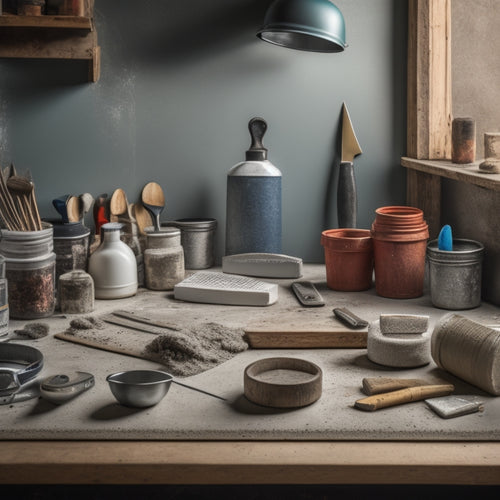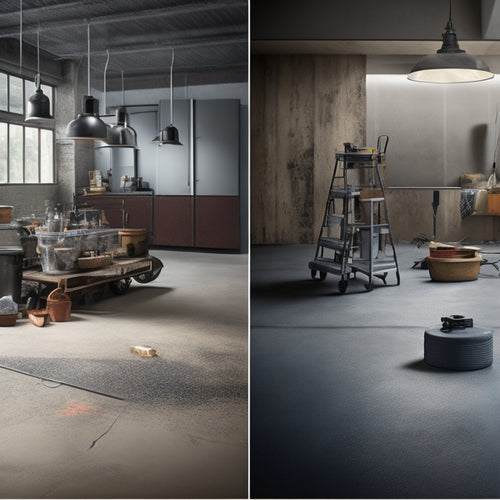
5 Must-Have Tools for Concrete Repair Success
Share
You'll need a crack detection kit with a flashlight, magnifying glass, and comparator to accurately assess damage extent. Mixing and application tools, like buckets, paddles, trowels, and putty knives, confirm consistent material mixing and proper application techniques. Thorough surface preparation requires cleaning tools like wire brushes, scrub brushes, or pressure washers, and a hammer and chisel to remove loose concrete. Epoxy injection guns and mixing systems are must-haves for precise resin application, while finishing and sealing tools, including steel trowels, flexible trowels, and sealant applicators, assure a professional finish. With these essentials, you'll be well on your way to achieving a successful, long-lasting concrete repair.
Key Takeaways
- A crack detection kit with a flashlight, magnifying glass, and comparator is essential for thorough crack evaluation and identification.
- Mixing buckets and paddles are must-haves for consistent material mixing, ensuring a strong bond between repair material and concrete.
- A wire brush, scrub brush, or pressure washer is necessary for thorough surface cleaning, critical for a strong bond between materials.
- Epoxy injection guns and mixing/metering systems provide precision and control for resin application, ensuring effective injection and filling solutions.
- A steel trowel is vital for smoothing and finishing concrete surfaces, while a sealant applicator ensures even application of sealants for protection against environmental factors.
Crack Detection Essentials
During the initial stages of concrete repair, identifying cracks is vital to determine the extent of damage and develop an effective repair strategy.
You'll need to conduct a thorough crack evaluation to identify the type, size, and location of cracks. This involves visually inspecting the concrete surface, looking for signs of damage such as cracks, spalls, or delamination.
You'll also need to analyze the crack's depth, width, and length to determine the best repair techniques. For example, hairline cracks may require only a simple sealant, while deeper cracks may need more extensive repair methods such as epoxy injection or routing and sealing.
Having the right tools for crack detection is essential. You'll need a crack detection kit that includes a flashlight, magnifying glass, and crack comparator to accurately measure crack width.
Additionally, a hammer and chisel may be necessary to remove loose concrete and debris from the crack area.
Mixing and Application Tools
With a thorough crack evaluation complete, you can now focus on preparing the necessary materials for repair. The next vital step is to mix and apply the concrete repair material. This requires the right tools to guarantee a successful repair.
You'll need the following essential mixing and application tools:
-
Mixing buckets and paddles: A clean, sturdy bucket and a mixing paddle or drill with a mixing bit are necessary for thorough mixing. This guarantees the repair material is consistent and free of lumps.
-
Application tools: Trowels, putty knives, or injection nozzles are used to apply the mixed material to the crack or damaged area. The choice of application tool depends on the size and location of the repair.
-
Finishing tools: Finishing tools like tamping tools or screeds help to smooth and finish the repair area, guaranteeing a uniform surface.
Mastering mixing techniques and application methods are essential to achieving a strong, long-lasting bond between the repair material and the existing concrete.
Surface Preparation Must-Haves
How thoroughly have you cleaned the surface of the concrete before applying the repair material? Proper surface preparation is essential for a successful concrete repair.
You'll need the right tools to guarantee a strong bond between the existing concrete and the repair material.
Surface cleaning is critical, as any dirt, oil, or other contaminants can compromise the bond. You'll need a wire brush or scrub brush to remove dirt and debris. A pressure washer can also be used to clean the surface, but be cautious not to damage the surrounding concrete.
After cleaning, you'll need to perform a substrate assessment to identify any cracks, voids, or other defects that may affect the repair. A hammer and chisel can be used to remove any loose or damaged concrete, while a vacuum or blower can remove dust and debris.
Injection and Filling Solutions
Several key tools are essential for successfully injecting and filling cracks and voids in concrete.
You'll need the right equipment to guarantee a strong, long-lasting bond and prevent further damage.
When it comes to epoxy injections, you'll need:
-
Epoxy injection guns: These tools allow you to inject epoxy resin into cracks and voids with precision and control.
-
Injection ports: These small devices are attached to the surface of the concrete and provide a pathway for the epoxy resin to flow into the crack or void.
-
Mixing and metering systems: These systems guarantee accurate mixing and dispensing of the epoxy resin, which is critical for achieving a strong bond.
In addition to epoxy injections, polyurethane fillers are also commonly used for filling larger voids and gaps.
These fillers expand to fill the void, providing a strong and durable bond.
With the right injection and filling solutions, you'll be able to effectively repair cracks and voids in concrete, guaranteeing a strong and durable structure.
Finishing and Sealing Tools
After successfully injecting and filling cracks and voids, it's time to focus on the final stage of concrete repair: finishing and sealing. This stage requires precision and attention to detail to guarantee a strong, durable, and visually appealing finish.
To achieve a professional finish, you'll need the right tools. Here are some must-haves:
| Tool | Description | Purpose |
|---|---|---|
| Steel Trowel | Rigid, flat blade for smoothing and finishing | Smoothes and flattens concrete surfaces |
| Flexible Trowel | Soft, flexible blade for curved or irregular surfaces | Finishes curved or irregular surfaces |
| Edger | Tool for creating clean edges and joints | Creates clean edges and joints |
| Sealant Applicator | Tool for applying sealants evenly | Applies sealants evenly and consistently |
| Sealant Options | Acrylic, epoxy, polyurethane, and silane-based sealants | Provides protection against water, chemicals, and UV rays |
When selecting trowel types, consider the surface you're working with and the desired finish. For sealant options, choose the one that best suits the environment and purpose of the repaired concrete.
Frequently Asked Questions
How Do I Ensure Worker Safety During Concrete Repair Projects?
When tackling concrete repair projects, you guarantee worker safety by conducting a thorough hazard assessment, providing proper safety equipment, and enforcing strict protocols to minimize risks, ultimately protecting your team from potential dangers.
Can I Use Concrete Repair Tools for Other Construction Tasks?
You'll find that many concrete repair tools can be repurposed for alternative construction applications, showcasing their versatility; for instance, a drill used for anchoring can also be used for installing fasteners in other projects.
What Is the Average Cost of Concrete Repair Tools and Equipment?
When selecting concrete repair tools, you'll need to evaluate cost factors, including the type and quality of equipment, brand, and quantity needed, which can range from a few hundred to several thousand dollars, depending on your specific tool selection.
Are Concrete Repair Tools Suitable for DIY Projects or Only Professionals?
Think you can tackle concrete repair like a pro? You're not alone! While DIY enthusiasts can handle small tasks with DIY techniques, complex projects demand professional techniques, and you'll likely need expert hands to achieve long-lasting results.
How Often Should I Maintain and Clean My Concrete Repair Tools?
You should maintain and clean your concrete repair tools daily, following proper cleaning techniques, to prevent corrosion and guarantee peak performance; dedicate time for thorough tool maintenance every week to extend their lifespan.
Conclusion
You've made it to the final stage of concrete repair - finishing and sealing. With the right tools, you've detected cracks, prepared surfaces, injected fillers, and applied new concrete. Now, guarantee a durable and long-lasting fix by sealing the deal. Will you settle for anything less than a flawless finish?
Related Posts
-

Essential Tools for Concrete Wall Covering Projects
When tackling a concrete wall covering project, you'll need a range of essential tools and equipment. For cleaning an...
-

Top Tools for Revamping Old Concrete Floors
You'll need a range of tools to revamp your old concrete floor, starting with epoxy, acrylic, or polyurethane paint, ...
-

Top Mixing Tools for DIY Concrete Block Laying
When it comes to DIY concrete block laying, the right mixing tools are vital for a strong and durable structure. You'...


